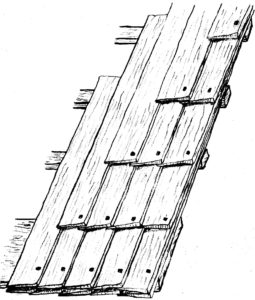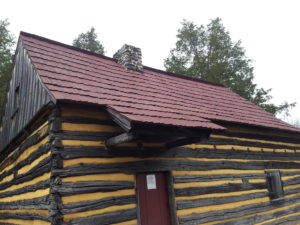Standing-seam rolled metal is today the most common vernacular roofing material in the Valley of Virginia. This was not always the case. From the time the earliest European settlers came to this region in the beginning of the second quarter of the eighteenth century until the decades after the Civil War, the most common way to roof a house or an outbuilding was with wooden shingles. Even so, how do we know that the Stone House had a wooden shingle roof on it in 1830? Apart from the original wooden roofing laths we have found nailed to the rafters in both sides of the house, there is other evidence that tells us that there was a wooden-shingle roof on the structure in 1830. When the owner of the Stone House Henry Jackson died in 1833, an inventory of his estate was taken for the court probate records. Among the things he owned at the time of his death listed in that inventory were two lots of roof shingles. One of these lots was estimated (or “supposed”) by the appraisers to contain 5,000 of what they called “Joint shingles.” The other lot was estimated to contain 1,000 of what they termed “lap shingles.” (We will discuss the difference between these two types of shingles below.) These shingles were among other building materials that Jackson owned when he died. In addition to this textual evidence we also have an historical photograph (see detail below) of the front of the log addition to the Stone House taken around 1885, when it was owned by the Argenbrights. It confirms that the structure still had a side-lap, wooden-shingle roof, though it was clearly in very rough shape at that time. It was probably about to be replaced with its first standing-seam rolled-metal panel roof.

The two types of shingles that Jackson owned when he died were the most commonly used in that era. Joint shingles are perhaps the ones we are most familiar with today. Also called “butt shingles,” they are laid flat on the roofing laths so that the side edges are closely abutting each other. They are nailed down in a pattern where the joints between the shingles are covered by the next course running above the one beneath. Sometimes their exposed ends are rounded to give a decorative “fish scale” appearance to the roof. (See image below.) This kind of shingle tends to be found most often in this region on structures that were associated with immigrants from Eastern Virginia who were of British extraction.

On the other hand, lap shingles are associated with those of German extraction. Architectural historians today often refer to the lap shingles used in this region by the name: long biaxially-tapered side-lap shingles. This term is more descriptive of their appearance. They are long. The ones we are having made will be at least thirty inches long. They are biaxially tapered, or wedge-shaped in profile, because they are split out of large red oak logs and then finished by shaving them smooth with a drawknife. The finished shingle is free of sapwood and core-heartwood.

The illustration above (based on a sketch first published in an article by Robert C. Bucher in Pennsylvania Folklife, Summer 1969) shows the way these side-lap shingles are installed. If things go as planned, we will begin to install a roof like this on the Stone House in the summer of 2019.

